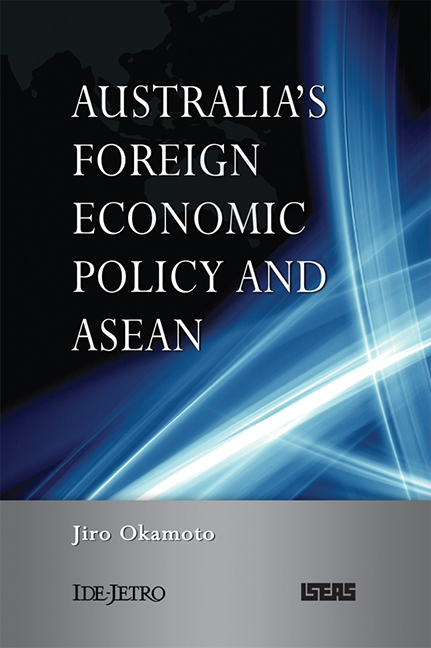Book contents
- Frontmatter
- Contents
- List of Figures and Tables
- Abbreviations and Acronyms
- Acknowledgements
- 1 Introduction
- 2 An Analytical Framework
- 3 State-Society Coalitions and Australia's Foreign Economic Policy
- 4 Australia and the Formation of ASEAN
- 5 The Trade Liberalizers and Asia-Pacific Regionalist Strategies
- 6 The Development of ASEAN Regionalism and the AFTA–CER Linkage Dialogue
- 7 The Bilateralists and their ASEAN Policy
- 8 Conclusion
- Appendix: Foreign Economic Policy-Related Ministers in Australia since 1941
- References
- Index
- About the Author
7 - The Bilateralists and their ASEAN Policy
Published online by Cambridge University Press: 21 October 2015
- Frontmatter
- Contents
- List of Figures and Tables
- Abbreviations and Acronyms
- Acknowledgements
- 1 Introduction
- 2 An Analytical Framework
- 3 State-Society Coalitions and Australia's Foreign Economic Policy
- 4 Australia and the Formation of ASEAN
- 5 The Trade Liberalizers and Asia-Pacific Regionalist Strategies
- 6 The Development of ASEAN Regionalism and the AFTA–CER Linkage Dialogue
- 7 The Bilateralists and their ASEAN Policy
- 8 Conclusion
- Appendix: Foreign Economic Policy-Related Ministers in Australia since 1941
- References
- Index
- About the Author
Summary
During the campaign for the March 1996 general election, Australia's relations with East Asia became one of the most debated issues. The Keating Government boasted about its diplomatic channels that were developed through the Cairns Group and APEC activities and criticized the Liberal and National Parties’ inexperience in this area (Takeda and Mori 1998, p. 178). The Liberals and Nationals in the opposition accepted that engagement with Asia should continue, yet they attacked the government for attaching too much importance to Asia and pressed the public to change the national identity. The Liberals and Nationals asserted that Australia's traditional values should be maintained (or restored) (Takeda et al. 2007, p. 96).
By the mid-1990s, in fact, public disquiet about the “Asianisation of Australia” (Cotton and Ravenhill 1997a, pp. 12–13; Milner 1997, pp. 35–36) had grown to a level where it could no longer be ignored politically (Cotton and Ravenhill 2001a, pp. 6–7; Milner 2001, p. 35). On top of the decade-long implementation of economic reforms which had led to reform-fatigue particularly among the low and middle income earners in rural areas, there was growing public uneasiness that the Keating Government' “big picture” vision of Australia's engagement with East Asia had gone too far. This formed part of the background to the demise of the Keating Government and the rise of the Liberal/National opposition under the leadership of John Howard in the 1996 general election (Wesley 2004, p. 153; 2007a, p. 140).
The new Howard Government initiated a review of the foreign economic policy of previous governments. This came to provide the platform for a major shift in Australia's foreign economic policy. The policy shift preferred by the new government led by Howard, who had been one of the leaders of the “dry” movement in the Liberal Party since the early 1980s, did not involve a wholesale return to the old protectionism. Rather, the pace of reform slowed initially and there was an appeal to reciprocity in international economic dealings and the pursuit of trade liberalization. The government was inclined to promote Australia's “national interest” through bilateral means, including free trade agreements that sought reciprocal liberalization and short-term, concrete economic benefits, rather than through multilateral negotiations.
- Type
- Chapter
- Information
- Australia's Foreign Economic Policy and ASEAN , pp. 204 - 246Publisher: ISEAS–Yusof Ishak InstitutePrint publication year: 2010

